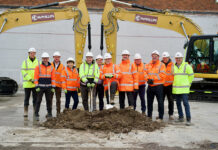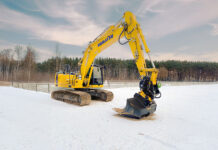TRACKED spider platforms have been available for many years – yet there are clear signs they are coming into their own for new building and maintenance challenges.
Building maintenance customers are looking for more cost-effective, agile and less intrusive ways to carry out essential work on taller buildings. Also, construction contractors are having to find different ways to work at height on sites made more congested by relaxation of planning rules that allow increased building density for tall building clusters.
On top of that, the electric power technology available on the latest tracked spider platforms is said to be allowing both contractors and end-use customers to benefit from sustainability advantages, including zero-emissions and low-noise operation.
Onestop Access, based in Hamilton, supplies tracked spider booms to the construction and property maintenance sector in Scotland. One of its latest projects was to hire a Hinowa Lightlift 26.14 Performance IIIS spider platform for painting work on social housing blocks at Drumchapel in Glasgow.
Onestop MD Robbie Jenkins said, “The only alternative for doing this work, because of the confined space in the courtyards of these blocks, would have been to scaffold the building. Using the Hinowa 26.14 allowed the access component of the job to be fulfilled at 20% of the cost of scaffolding, saving the property landlord a lot of money.
“The spider platform can also be operated with electric power, so it’s quiet and pollution free, which is very helpful for residents while the work is being carried out.”
Despite these advantages, Jenkins said many contractors are still wedded to the idea of scaffolding for jobs that are well suited to the use of powered access – and where space is constrained, to tracked platforms.
The Hinowa LL 26.14 has a maximum operating height of 25.7m and an outreach of 13.6m. It weighs 4.8t, is 6m long, and just 1m wide when set for tracking.
The big advantage of wheeled boom lifts is that they are self-propelled, so can be driven from one work location to another while still at height. However, on some modern construction sites, manoeuvrability is offset by bulk, and construction contractors are also turning to spider platforms to work at height, especially during the façade installation and fitout stage.
Shane Paver, Scottish sales director for Access Platform Sales (APS), the UK and Ireland distributor for Hinowa spider platforms, said their use on congested high-rise construction sites is a growing trend.
APS recently sold new bi-energy Hinowa Lightlift 33.17 Performance IIIS spider platforms to hire firms in Dublin and London specifically because they are in demand for tall building projects, and he expects this to be a coming trend in Scottish cities too.
“As population growth puts pressure on land availability, city planners are relaxing regulations to increase building density,” he explained. “At the same time, they’re allowing the development of strategic tall building clusters. This is feeding demand for taller and taller spider platforms like the bi-energy Hinowa 33.17, which can work at up to 32.5m across low-load bearing ground yet is zero-emission and low noise.
“That’s perfect for working on phased tall building projects and aligns with the construction industry’s drive to low-carbon, sustainable development.”











